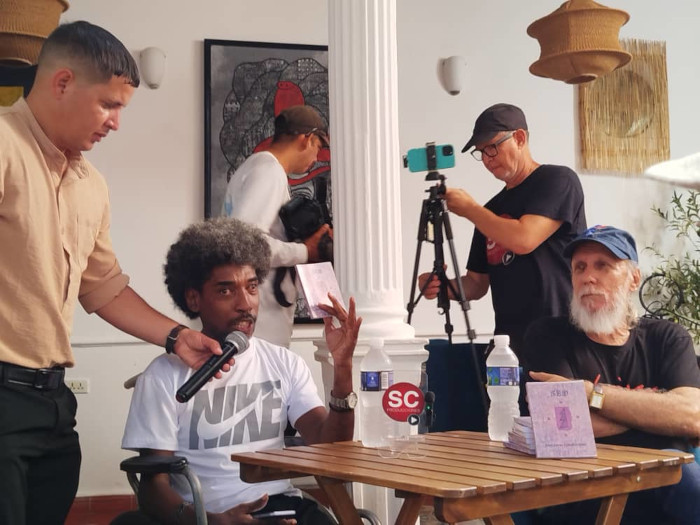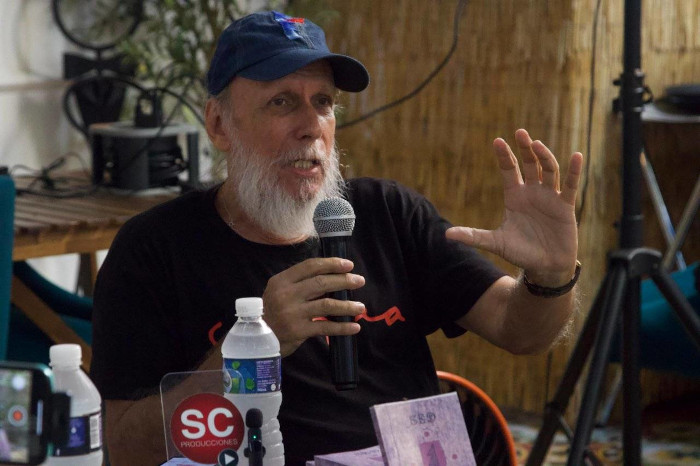CAMAGÜEY — Joel Jover’s gallery of poems expands with Thirst (Sed, Ácana Publishing, 2025), a book that both quenches — and awakens — the need to look inward. With the same intensity with which he paints, the Camagüey-born creator now offers a collection of poems where images are breathed, drunk, and heard.
At the start of the Cuban Culture Week in Camagüey, poetry once again took on the color of time. At the headquarters of Sabor y Arte, the family venture he shares with fellow artist Ileana Sánchez, a book was presented that, in his own words, “is not small because of its size, but because of its intention.” In that humility, in that luminous brevity, lies its strength.

“It’s a book that tries to speak to people without pretension,” he says. “A book of images, as if one were contemplating a painting. The sap running through it is the idea of disconnection, of the personal thirst for what wasn’t done or even attempted. It is, of course, a book of old age. As Reinaldo Arenas said: Do it quickly, before night falls.”
Each verse in Thirst seems to emerge from a pictorial silence, from those spaces where Jover pauses to observe the world without haste. He does not write from technique, but from vision: “I’m a painter,” he confesses. “That book is made of images. I don’t consider myself a writer — I’m a reader who writes.”
His bond with words is not new. Earlier, in Self-Portrait with Fish and Sea in the Background, also published by Ácana, he left a first poetic trace. But now the voice arrives calmer, more intimate: “At this point I don’t intend anything anymore. Not out of fatigue, but because pretension is like fabricating an image before you’ve truly seen it. Now it’s enough for me to look at the yard full of leaves and understand that the wind has passed. All I want is peace and quiet.”
Jover’s poetry doesn’t aim to replace painting, but to complete it. Some images, he admits, couldn’t exist on canvas: “It’s not that poetry is what’s left over from the painter. There are things I can’t achieve technically in painting. I realize some ideas aren’t meant to be painted — they’re meant to be written. Sometimes the opposite happens, like Self-Portrait..., where the poem became a painting, but that’s rare.”
As in his visual art, there is deliberate restraint in his poetry. The poems in Thirst are brief, precise — brushstrokes that need nothing more to reveal the essential. “From the beginning, I knew I couldn’t write anything longer,” he says. “They have to be two or three lines, because it’s about the image. Each poem stands on its own — and I just hope it touches people’s hearts.”
In his work, poetry isn’t a complement but a continuation. Thirst confirms that, for Joel Jover, art is a way of breathing and remembering — an inner gallery where paintings can also speak.
During the book’s presentation, poet Jesús Zamora emphasized that “poetry must defend itself.” The event also highlighted the illustrations made by the author himself, who was modestly critical of his own work: “The illustrations are the least spiritual part of the book,” he admitted.
Jover has other literary projects in progress. He’s working on a collection of short stories about missed encounters — people who should have met, but didn’t, at the right time. A finished novel, La retinga del Diablo (“The Devil’s Anchorage”), awaits publication. The title, he explains, comes from a small bay in Nuevitas, where fishermen once took refuge from storms — and from a brothel that shared the same name.
“The novel talks about all that. It has many hints, more than fifty literary references. Someone walks past La Retinga del Diablo and says, ‘They’re painting the façade red, but it used to be green.’ It’s a wink to The Green House by Vargas Llosa.”
His relationship with literature began early, in his native Nuevitas, when he attended Enrique Cirules’s literary workshop. “There I wrote a story called The Staircase, about a man trying to climb three steps to feel recognized. That was my feeling then — the need to climb.”
He admits that whenever he does something related to literature, he feels “impostor syndrome,” and recalls his art school days: “I learned technique — though not much,” he laughs. “I’ve always thought technique only exists to destroy it immediately. In art, what matters most is breaking the rules.”
The presentation of Thirst brought together friends, writers, artists, and readers. In that atmosphere of dialogue and affection, the audience listened to the painter-poet speak of his work with the calmness of someone still creating from the essence.
“As Picasso said: ‘I don’t seek — I find.’ That’s enough for me,” Jover concluded. “To find peace, calm, and to keep looking at the world with curiosity.”
Translated by Linet Acuña Quilez



